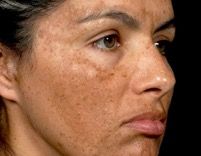MELASMA
 Melasma is a skin condition presenting as brown patches on the face of adults. Both sides of the face are usually affected. The most common sites of involvement are the cheeks, bridge of nose, forehead, and upper lip. It is also referred to as the “mask of pregnancy”. It is not a harmful disease, but can severely affect a person’s cosmetic appearance.
Melasma is a skin condition presenting as brown patches on the face of adults. Both sides of the face are usually affected. The most common sites of involvement are the cheeks, bridge of nose, forehead, and upper lip. It is also referred to as the “mask of pregnancy”. It is not a harmful disease, but can severely affect a person’s cosmetic appearance.
Melasma mostly occurs in women. Only 10% of those affected are men. Dark-skinned races, particularly Hispanics, Asians, Indians, people from the Middle East, and Northern Africa, tend to have melasma more than others. The precise cause of melasma is unknown. People with a family history of melasma are more likely to develop melasma themselves. It may also develop in persons taking oral contraceptives, hormone replacement therapy, or excessive sun exposure.
Treatment
Sunscreens are essential in the prevention of melasma. They should be broad spectrum, protecting against both UVA and UVB rays from the sun. A SPF 30 or higher should be selected. In addition, physical sunblock lotions and creams such as zinc oxide and titanium oxide may be used to block ultraviolet radiation and visible light. Sunscreens should be worn daily, whether or not it is sunny outside, or if you are outdoors or indoors. A significant amount of ultraviolet rays is received while walking down the street, driving in cars, and sitting next to windows. Which is why Dr. Green will recommend some form of sunblock to protect your melasma from worsening or even returning.
Melasma may slowly fade after delivery, or it may remain for many years or even a lifetime. Similarly, if melasma develops after starting birth control pills, it may improve after discontinuing them. Darkening will most likely reoccur with subsequent pregnancies or reintroduction of oral contraceptives.
Typically, Dr. Green treats Melasma with hydroquinone (a bleaching cream) and kojic acid that he formulates and can be administered while continuing the birth control pills. Dr. Green also likes to add a bleaching cream in conjunction with glycolic acid, and retinol to maximize the effects. The topical depigmenting process is slow, therefore Dr. Green also offers quicker techniques to help reduce the melasma, such as chemical peels, microdermabrasion, and laser treatments.


